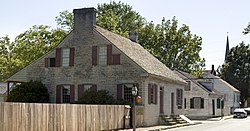Ste. Genevieve Historic District
|
Ste. Genevieve Historic District
|
|

Felix Vallé State Historic Site, within the historic district
|
|
| Location | Ste. Genevieve, Missouri |
|---|---|
| Coordinates | 37°58′37″N 90°02′55″W / 37.97696°N 90.048672°WCoordinates: 37°58′37″N 90°02′55″W / 37.97696°N 90.048672°W |
| Built | 1750 |
| Architect | Unknown |
| Architectural style | Colonial, Other |
| NRHP reference # | 66000892 and 02000357 |
| Significant dates | |
| Added to NRHP | October 15, 1966, boundary increase April 11, 2002 |
| Designated NHLD | October 9, 1960 |
Ste. Genevieve Historic District is a historic district encompassing much of the built environment of Ste. Genevieve, Missouri. The city was in the late 18th century the capital of Spanish Louisiana, and, at its original location a few miles south, capital of French Louisiana as well. A large area of the city, including fields along the Mississippi River, is a National Historic Landmark District designated in 1960, for its historically French architecture and land-use patterns, while a smaller area, encompasses the parts of the city historically important between about 1790 and 1950, was named separately to the National Register of Historic Places in 2002.
Ste. Genevieve is home to one of the highest concentrations of distinctive types of French colonial architecture known as poteaux en terre, or post in ground, and Poteaux-sur-sol, or post on sill. Both of these styles involve construction of walls consisting of vertical logs, the former placed directly into the ground, and the latter onto a horizontal sill of wood or stone. Prominent local examples of these architectural styles include the Beauvais-Amoureux House, the Felix Vallé House State Historic Site, La Maison de Guibourd, the Delassus-Kern House, the Louis Bolduc House (itself listed separately as a National Historic Landmark).
Ste. Genevieve was established in the 1750s by French colonists, when the territory west of the Mississippi River was part of French Louisiana. It became the principle civic center of the region, and continued to be so when the area passed into Spanish control with the Treaty of Paris in 1763. The original site of Ste. Genevieve, about 3 miles (4.8 km) south of the present city, was severely damaged by major flooding in 1785. After this event, the city was, over the next ten years, relocated to its present site on higher ground. The oldest surviving buildings in the city date to this period, with the church moved from its old site in 1793. The agricultural area just outside the city to the southeast is largely still laid out as it was at that time, following traditional French colonial lines.
...
Wikipedia


